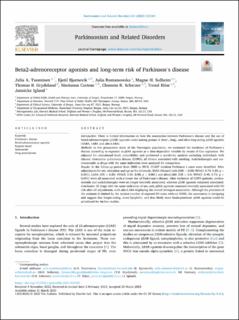| dc.description.abstract | Introduction
There is limited information on how the association between Parkinson's disease and the use of beta2-adrenoreceptor (β2AR) agonists varies among groups of short-, long-, and ultra-long-acting β2AR agonists (SABA, LABA and ultraLABA).
Methods
In this prospective study of the Norwegian population, we estimated the incidence of Parkinson's disease according to exposure to β2AR agonists as a time-dependent variable by means of Cox regression. We adjusted for educational level, comorbidity and performed a sensitivity analysis excluding individuals with chronic obstructive pulmonary disease (COPD), all factors associated with smoking. Anticholinergics and corticosteroids as drugs with the same indication were analyzed for comparison.
Results
In the follow-up period from 2005 to 2019, 15,807 incident Parkinson's cases were identified. After adjustments for sex, education and age as the timescale, SABA (Hazard ratio (HR) = 0.84; 95%CI: 0.79, 0.89; p < 0.001), LABA (HR = 0.85; 95%CI: 0.81, 0.90; p < 0.001) and ultraLABA (HR = 0.6; 95%CI: 0.49, 0.73; p < 0.001) were all associated with a lower risk of Parkinson's disease. After exclusion of COPD patients, corticosteroids and anticholinergics were no longer inversely associated, whereas β2AR agonists remained associated.
Conclusion
Of drugs with the same indication of use, only β2AR agonists remained inversely associated with PD risk after all adjustments, with ultraLABA displaying the overall strongest association. Although the precision of the estimate is limited by the modest number of exposed PD cases without COPD, the association is intriguing and suggest that longer-acting, more lipophilic, and thus likely more brain-penetrant β2AR agonists could be prioritized for further studies. | en_US |

